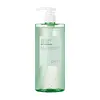What's inside
What's inside
 Key Ingredients
Key Ingredients

No key ingredients
 Benefits
Benefits

 Concerns
Concerns

 Ingredients Side-by-side
Ingredients Side-by-side

Water
Skin ConditioningLauryl Betaine
CleansingSodium C14-16 Olefin Sulfonate
CleansingGlycerin
HumectantSodium Chloride
MaskingPropylene Glycol Laurate
Skin ConditioningCaprylyl Glycol
EmollientEthylhexylglycerin
Skin ConditioningC12-14 Pareth-12
EmulsifyingCitric Acid
BufferingDisodium EDTA
Panthenol
Skin ConditioningLaurylpyridinium Chloride
AntimicrobialHexylene Glycol
EmulsifyingLevulinic Acid
PerfumingSodium Bicarbonate
AbrasiveCamellia Sinensis Leaf Extract
Antimicrobial1,2-Hexanediol
Skin ConditioningButylene Glycol
HumectantCentella Asiatica Extract
CleansingMelaleuca Alternifolia Leaf Extract
PerfumingAsiatic Acid
Skin ConditioningAsiaticoside
AntioxidantMadecassic Acid
Skin ConditioningMadecassoside
AntioxidantCitrus Aurantium Dulcis Peel Oil
MaskingAmyris Balsamifera Bark Oil
MaskingCitrus Paradisi Peel Oil
MaskingLavandula Angustifolia Oil
MaskingPelargonium Graveolens Flower Oil
MaskingEucalyptus Globulus Leaf Oil
PerfumingLitsea Cubeba Fruit Oil
MaskingMelaleuca Alternifolia Leaf Oil
AntioxidantMentha Arvensis Leaf Oil
MaskingBoswellia Serrata Oil
MaskingJuniperus Mexicana Oil
MaskingMyristica Fragrans Kernel Oil
MaskingLimonene
PerfumingCitral
PerfumingWater, Lauryl Betaine, Sodium C14-16 Olefin Sulfonate, Glycerin, Sodium Chloride, Propylene Glycol Laurate, Caprylyl Glycol, Ethylhexylglycerin, C12-14 Pareth-12, Citric Acid, Disodium EDTA, Panthenol, Laurylpyridinium Chloride, Hexylene Glycol, Levulinic Acid, Sodium Bicarbonate, Camellia Sinensis Leaf Extract, 1,2-Hexanediol, Butylene Glycol, Centella Asiatica Extract, Melaleuca Alternifolia Leaf Extract, Asiatic Acid, Asiaticoside, Madecassic Acid, Madecassoside, Citrus Aurantium Dulcis Peel Oil, Amyris Balsamifera Bark Oil, Citrus Paradisi Peel Oil, Lavandula Angustifolia Oil, Pelargonium Graveolens Flower Oil, Eucalyptus Globulus Leaf Oil, Litsea Cubeba Fruit Oil, Melaleuca Alternifolia Leaf Oil, Mentha Arvensis Leaf Oil, Boswellia Serrata Oil, Juniperus Mexicana Oil, Myristica Fragrans Kernel Oil, Limonene, Citral
Water
Skin ConditioningButylene Glycol
HumectantDipropylene Glycol
HumectantGlycerin
HumectantBetaine
HumectantPEG-60 Hydrogenated Castor Oil
EmulsifyingPanthenol
Skin ConditioningActinidia Chinensis Fruit Extract
EmollientVitis Vinifera Fruit Extract
Skin ConditioningSpinacia Oleracea Leaf Extract
Skin ConditioningBrassica Oleracea Acephala Leaf Extract
HumectantBrassica Oleracea Gemmifera Extract
AstringentBrassica Oleracea Capitata Leaf Extract
Skin ConditioningBrassica Oleracea Italica Extract
AstringentBrassica Oleracea Botrytis Extract
Skin ConditioningApium Graveolens Extract
Skin ConditioningArtemisia Princeps Leaf Extract
Skin ConditioningPisum Sativum Extract
Skin ConditioningPrunus Mume Fruit Extract
HumectantPolyglutamic Acid
Skin ConditioningXanthan Gum
EmulsifyingDisodium EDTA
Ethylhexylglycerin
Skin Conditioning1,2-Hexanediol
Skin ConditioningPhenoxyethanol
PreservativeParfum
MaskingWater, Butylene Glycol, Dipropylene Glycol, Glycerin, Betaine, PEG-60 Hydrogenated Castor Oil, Panthenol, Actinidia Chinensis Fruit Extract, Vitis Vinifera Fruit Extract, Spinacia Oleracea Leaf Extract, Brassica Oleracea Acephala Leaf Extract, Brassica Oleracea Gemmifera Extract, Brassica Oleracea Capitata Leaf Extract, Brassica Oleracea Italica Extract, Brassica Oleracea Botrytis Extract, Apium Graveolens Extract, Artemisia Princeps Leaf Extract, Pisum Sativum Extract, Prunus Mume Fruit Extract, Polyglutamic Acid, Xanthan Gum, Disodium EDTA, Ethylhexylglycerin, 1,2-Hexanediol, Phenoxyethanol, Parfum
Ingredients Explained
These ingredients are found in both products.
Ingredients higher up in an ingredient list are typically present in a larger amount.
1,2-Hexanediol is a synthetic liquid and another multi-functional powerhouse.
It is a:
- Humectant, drawing moisture into the skin
- Emollient, helping to soften skin
- Solvent, dispersing and stabilizing formulas
- Preservative booster, enhancing the antimicrobial activity of other preservatives
Butylene Glycol (or BG) is used within cosmetic products for a few different reasons:
Overall, Butylene Glycol is a safe and well-rounded ingredient that works well with other ingredients.
Though this ingredient works well with most skin types, some people with sensitive skin may experience a reaction such as allergic rashes, closed comedones, or itchiness.
Learn more about Butylene GlycolDisodium EDTA plays a role in making products more stable by aiding other preservatives.
It is a chelating agent, meaning it neutralizes metal ions that may be found in a product.
Disodium EDTA is a salt of edetic acid and is found to be safe in cosmetic ingredients.
Learn more about Disodium EDTAEthylhexylglycerin (we can't pronounce this either) is commonly used as a preservative and skin softener. It is derived from glyceryl.
You might see Ethylhexylglycerin often paired with other preservatives such as phenoxyethanol. Ethylhexylglycerin has been found to increase the effectiveness of these other preservatives.
Glycerin is already naturally found in your skin. It helps moisturize and protect your skin.
A study from 2016 found glycerin to be more effective as a humectant than AHAs and hyaluronic acid.
As a humectant, it helps the skin stay hydrated by pulling moisture to your skin. The low molecular weight of glycerin allows it to pull moisture into the deeper layers of your skin.
Hydrated skin improves your skin barrier; Your skin barrier helps protect against irritants and bacteria.
Glycerin has also been found to have antimicrobial and antiviral properties. Due to these properties, glycerin is often used in wound and burn treatments.
In cosmetics, glycerin is usually derived from plants such as soybean or palm. However, it can also be sourced from animals, such as tallow or animal fat.
This ingredient is organic, colorless, odorless, and non-toxic.
Glycerin is the name for this ingredient in American English. British English uses Glycerol/Glycerine.
Learn more about GlycerinPanthenol is a common ingredient that helps hydrate and soothe the skin. It is found naturally in our skin and hair.
There are two forms of panthenol: D and L.
D-panthenol is also known as dexpanthenol. Most cosmetics use dexpanthenol or a mixture of D and L-panthenol.
Panthenol is famous due to its ability to go deeper into the skin's layers. Using this ingredient has numerous pros (and no cons):
Like hyaluronic acid, panthenol is a humectant. Humectants are able to bind and hold large amounts of water to keep skin hydrated.
This ingredient works well for wound healing. It works by increasing tissue in the wound and helps close open wounds.
Once oxidized, panthenol converts to pantothenic acid. Panthothenic acid is found in all living cells.
This ingredient is also referred to as pro-vitamin B5.
Learn more about PanthenolWater. It's the most common cosmetic ingredient of all. You'll usually see it at the top of ingredient lists, meaning that it makes up the largest part of the product.
So why is it so popular? Water most often acts as a solvent - this means that it helps dissolve other ingredients into the formulation.
You'll also recognize water as that liquid we all need to stay alive. If you see this, drink a glass of water. Stay hydrated!
Learn more about Water